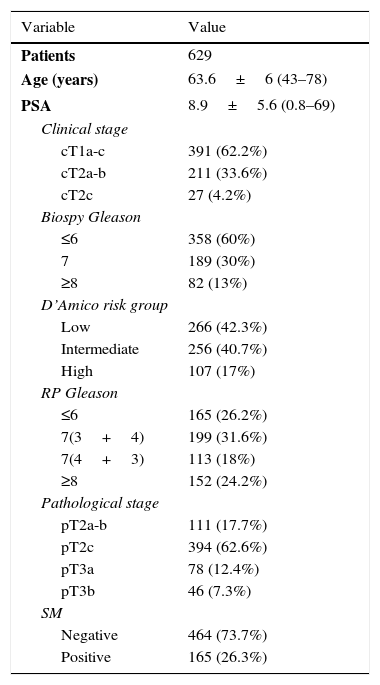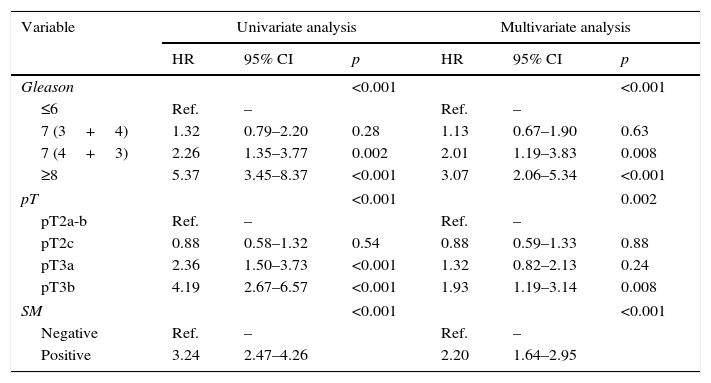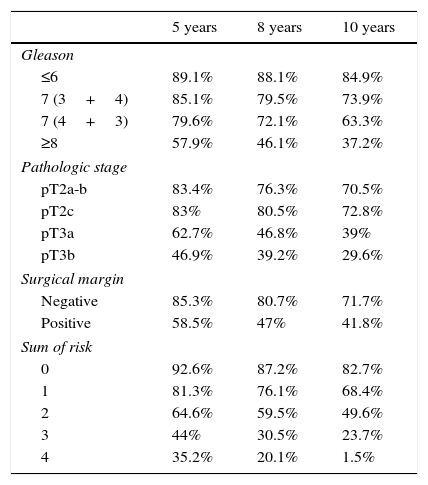To design a risk summation to select patients for adjuvant radiation therapy after prostatectomy.
Materials and methodA retrospective study was conducted on 629 patients with localized prostate cancer (pN0–pNx) who were treated with prostatectomy and with a prostate-specific antigen (PSA) value <0.2ng/ml at 2–3 months. Biochemical recurrence was defined as a PSA >0.4ng/ml. A multivariate Cox regression analysis was performed. A score (0–2) was assigned according to the hazard ratio of the significant variables. The score summation defined the risk summation.
ResultsA total of 19.7% of the patients were pT3, 24.2% had a Gleason score ≥8, and 26.3% had positive surgical margins. The median follow-up was 82 months. Some 26.6% of the patients experienced biochemical recurrence. The identified prognostic variables independent of biochemical recurrence were a Gleason score =7 (4+3) (HR, 2.01; p=.008), a Gleason score ≥8 (HR, 3.07; p<.001), a pT3b stage (HR, 1.93; p=.008) and a positive surgical margin (HR, 2.20; p<.001). We assigned 0 points to patients without risk prognosis variables; 1 point to patients with Gleason scores=7 (4+3), pT3b or positive surgical margins; and 2 points to patients with Gleason scores ≥8. The patients with a risk summation ≤2 had >50% survival free of biochemical recurrence at 5 and 8 years. In contrast, the patients with a risk summation ≥3 had <44% survival free of biochemical recurrence.
ConclusionThe patients with a risk summation ≤2 did not benefit from adjuvant radiation therapy, while the patients with a risk summation ≥3 might benefit from adjuvant radiation therapy.
Diseñar un sumatorio de riesgo para la selección de pacientes para radioterapia adyuvante después de prostatectomía.
Material y métodoEstudio retrospectivo de 629 pacientes con cáncer de próstata localizado y pN0-pNx tratados con prostatectomía y con un PSA a los 2-3 meses <0,2ng/ml. Recidiva bioquímica si PSA > 0,4ng/ml. Análisis multivariante mediante regresión de Cox. Asignación de puntuación (0-2) en función del HR de las variables significativas. El sumatorio de las puntuaciones definió el sumatorio de riesgo.
ResultadosEl 19,7% pT3, 24,2% Gleason ≥8 y el 26,3% de márgenes quirúrgicos positivos. Mediana de seguimiento de 82 meses. Recidiva bioquímica el 26,6%. El Gleason=7 (4+3) (HR=2,01, p=0,008), el Gleason ≥8 (HR=3,07, p<0,001), el estadio pT3b (HR=1,93, p=0,008) y el margen quirúrgico positivo (HR=2,20, p<0,001) se identificaron como variables pronosticas independientes de recidiva bioquímica. Se asignó 0 puntos a los pacientes sin variables pronósticas de riesgo, un punto a los pacientes con Gleason=7 (4+3), pT3b o márgenes quirúrgicos positivos y 2 puntos si Gleason ≥8. Los pacientes con un sumatorio de riesgo ≤2 tuvieron una supervivencia libre de recidiva bioquímica a los 5 y 8 años superior al 50%, en cambio, los pacientes con un sumatorio de riesgo ≥3 tuvieron una supervivencia libre de recidiva bioquímica inferior al 44%.
ConclusiónLos pacientes con un sumatorio de riesgo ≤2 no se beneficiarían de radioterapia adyuvante, mientras que los pacientes con un sumatorio de riesgo ≥3 pudieran beneficiarse de radioterapia adyuvante.










